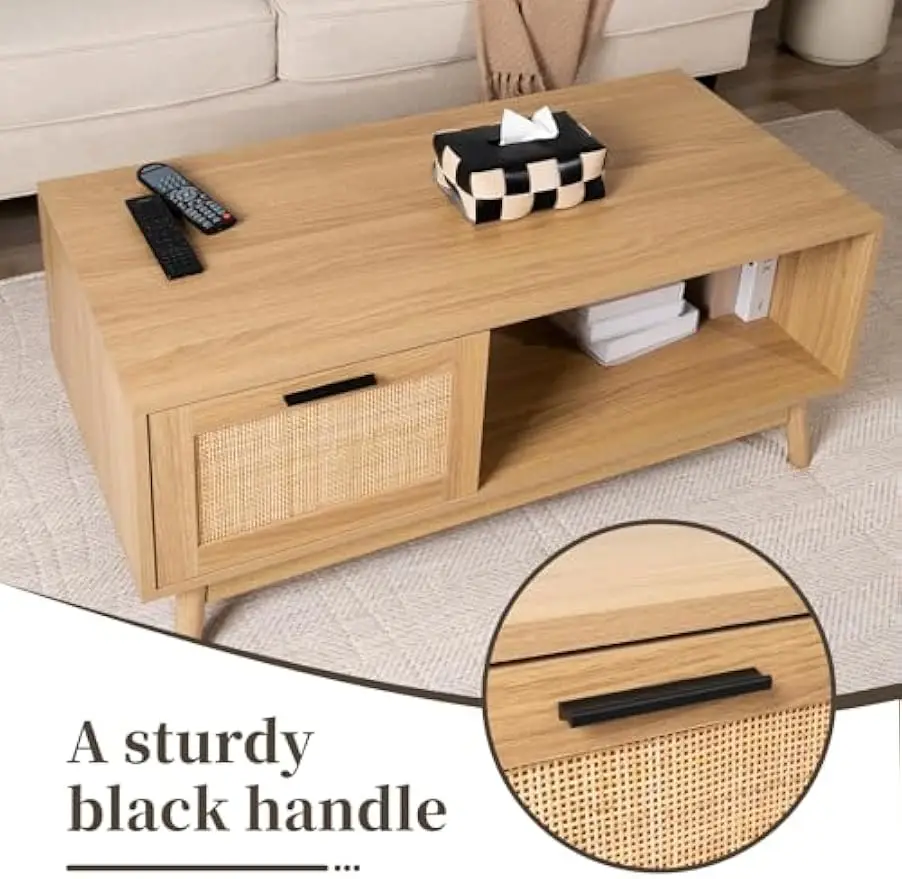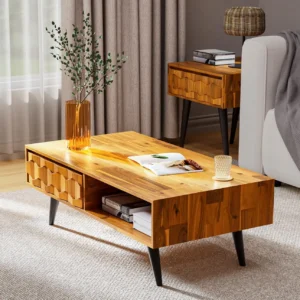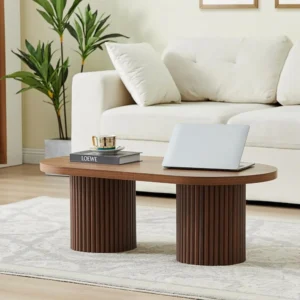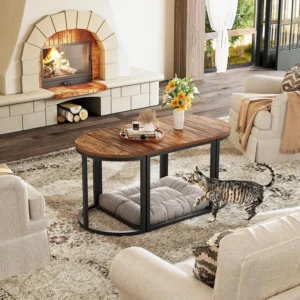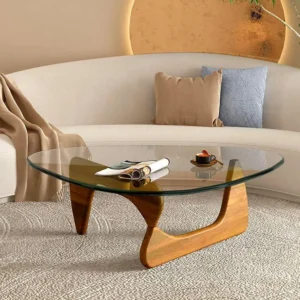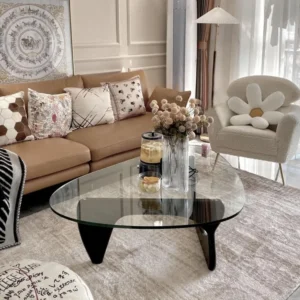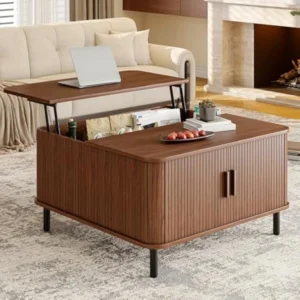Why Vintage Coffee Tables Have Become Sought-After Statement Pieces
In a world of mass production and cookie-cutter furniture, vintage coffee tables stand apart as distinctive treasures that bring both history and character into our homes. These special pieces offer something that new furniture simply cannot – a unique story, exceptional craftsmanship, and design elements that have stood the test of time.
What exactly makes a coffee table truly “vintage” with “character”? It’s more than just age. Character comes from the beautiful patina that develops over decades of use, the meticulous craftsmanship from an era when furniture was built to last generations, and design details that reflect specific artistic movements and cultural moments.
These character-rich coffee tables have become increasingly popular as homeowners seek to create living spaces with personality and depth. Unlike contemporary mass-produced items, a vintage coffee table serves as an instant conversation piece – a focal point that anchors your living space while adding warmth and visual interest.
The trend of incorporating vintage coffee table options into modern interiors continues to grow, with design enthusiasts particularly drawn to the way these pieces add sophistication and authenticity to a room. The demand for quality vintage pieces has risen substantially, reflecting our collective desire for homes that feel more personal and less generic.
Throughout this guide, we’ll explore the remarkable world of vintage coffee tables with character – from identifying quality pieces across different design eras to finding the perfect table for your specific space. Whether you’re drawn to the clean lines of mid-century design or the ornate details of earlier periods, understanding how to style vintage pieces effectively will help you create a living space that’s both timeless and uniquely yours.
The Undeniable Advantages of Choosing Vintage Over New
When considering a coffee table for your living space, vintage options offer several compelling benefits that new furniture simply cannot match:
Exceptional Character and Uniqueness
- Each vintage piece tells its own story through distinctive features, marks, and patina
- No two vintage tables are exactly alike, unlike mass-produced modern pieces
- Original design quirks and details give your space authentic personality
- The uniqueness ensures your home won’t look like a furniture showroom copy
Superior Craftsmanship and Materials
- Vintage tables were often handcrafted using traditional woodworking techniques
- Many feature joinery methods rarely seen in modern production (dovetail joints, mortise and tenon)
- Older pieces frequently incorporate solid hardwoods rather than veneers or engineered wood
- Materials like old-growth timber and hand-forged metal components are increasingly rare in new furniture
The features that make vintage pieces special extend beyond their physical construction to include their environmental impact and financial considerations.
Environmental Sustainability
- Choosing vintage means no new resources are consumed in manufacturing
- Extends the useful life of existing furniture, reducing landfill waste
- Avoids the carbon footprint associated with new production and shipping
- Supports the circular economy of reuse and repurposing
Design Authenticity
- Original vintage pieces carry true design heritage rather than mimicking a style
- Authentic proportions and details that reproductions often miss or simplify
- Genuine aging that cannot be artificially replicated in new “distressed” furniture
- Connection to specific design movements and their historical context
Investment Potential
- Quality vintage pieces often maintain or increase their value over time
- Some designs become increasingly sought-after as they become more scarce
- Well-maintained vintage furniture can be resold rather than discarded
- Potential to own pieces that appreciate while you enjoy them
Conversation Starters
- Vintage tables naturally inspire curiosity and questions from guests
- Each piece has a history that adds depth to your living space
- The stories behind vintage furniture create emotional connections
- Distinctive character elements become focal points in your room’s design
By choosing a vintage coffee table with genuine character, you’re not just furnishing your home—you’re adding a piece with soul, sustainability, and style that stands apart in today’s world of disposable design.
Defining Character: Elements That Make Vintage Coffee Tables Special
What truly gives a vintage coffee table its distinctive character? It’s a combination of tangible and intangible qualities that develop over time and through craftsmanship. Understanding these elements helps you recognize pieces with genuine character and value.
Materials with Soul
The materials used in vintage coffee tables develop a unique presence over time that new pieces simply cannot replicate. Wood surfaces develop a rich patina through decades of gentle use and oxidation. This natural aging process brings out deeper colors and grain patterns that give each piece its distinctive personality.
Metals like brass and bronze develop complex patinas that reflect their history—the warm golden tones deepen and develop subtle variations that only time can create. Even chrome and steel elements age in characteristic ways, developing a soft luster or interesting wear patterns that tell the story of the piece.
The design elements that create character are fundamentally tied to these material qualities. Look for woods that show their age honestly through color deepening rather than damage, and metal components that wear gracefully rather than deteriorate.
Artisanal Craftsmanship
Vintage coffee tables often showcase handcraft techniques that have become increasingly rare in today’s manufacturing landscape. Hand-cut joinery creates stronger, more precise connections between components. Look for dovetail joints in drawers, mortise and tenon connections, and other traditional woodworking methods that indicate quality construction.
The precision of hand-finished edges and surfaces also contributes significantly to a piece’s character. Subtle details like chamfered edges, hand-carved elements, or custom inlays demonstrate the care and skill invested in the table’s creation. These handmade touches create a warmth and authenticity that machine-produced furniture rarely achieves.
Design Innovation
Many vintage coffee tables represent bold experiments in design from their respective eras. Revolutionary uses of materials, like bent plywood or molded fiberglass, showcase the innovative spirit behind many vintage pieces. Experimental forms that broke from tradition often become the most iconic and character-rich tables decades later.
The proportion and balance of elements in vintage designs frequently demonstrate sophisticated design principles. The relationship between top and base, the placement of supports, and the overall silhouette reflect thoughtful design considerations that give each piece its unique presence.
Signs of History
Honest wear patterns tell the story of a table’s life and use. Small nicks, subtle color variations, and gentle wear on edges can enhance rather than detract from character. Unlike damage, these signs of history add authenticity and depth to a vintage piece.
Many teak coffee tables with distinctive patina show how this natural aging process creates beauty over time. The honey-gold color that develops in teak becomes richer and more complex with exposure to air and gentle use, creating a warmth that new furniture cannot match.
Distinctive Silhouettes
Unusual shapes and proportions often define character-rich vintage tables. From kidney-shaped tops to sculptural bases, these distinctive forms represent specific design movements and aesthetic philosophies. Original design details like floating tops, unexpected leg placements, or interesting structural solutions create visual interest and conversation starters.
These character elements combine to create coffee tables that are more than just functional surfaces—they’re expressions of design history, craftsmanship, and the natural beauty of materials allowed to age gracefully.
Essential Materials That Define Vintage Coffee Table Character
The materials used in vintage coffee tables contribute significantly to their distinctive character and appeal. Understanding these materials helps you identify quality pieces and appreciate their unique properties.
Classic Woods
Teak: Prized in mid-century design, teak develops a honey-golden patina over time that gives it unmistakable warmth. Its natural oils make it resistant to water damage and decay, allowing solid wood vintage tables to maintain their beauty for generations. Look for the smooth, even grain and rich color variations that indicate quality teak.
Walnut: With its chocolate-brown tones and distinctive grain patterns, walnut brings sophisticated darkness to vintage designs. American black walnut was particularly favored by mid-century designers for its strength and visual richness. The wood ages beautifully, developing deeper color and character over decades.
Rosewood: Featuring dramatic grain patterns with dark stripes against lighter backgrounds, rosewood was used in premium vintage pieces. Its density and natural oils create a smooth finish that feels luxurious to the touch. Due to conservation restrictions, vintage rosewood pieces are increasingly valuable.
Oak: Strong and durable with prominent grain patterns, oak was commonly used in various vintage styles from Mission to mid-century. It develops a golden-honey patina over time and shows its age through deepening color rather than deterioration.
Mahogany: With its reddish-brown color and straight grain, mahogany brings elegance to vintage tables. It was often used in traditional and formal designs, polishing to a high sheen that develops character and depth over decades.
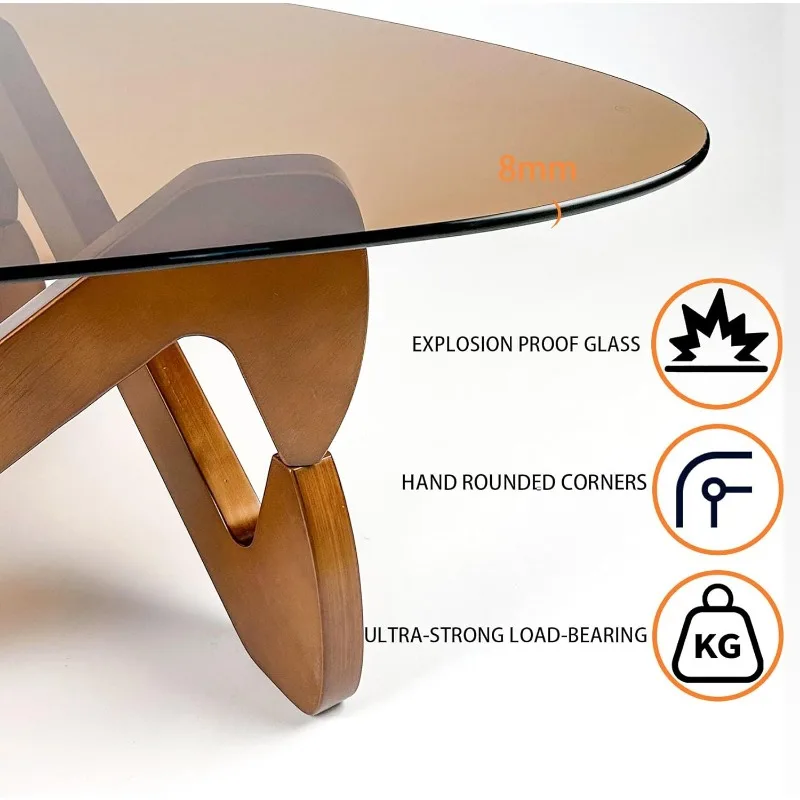
Metals and Hardware
Brass: Often found on drawer pulls, legs, or decorative elements, brass develops a warm patina that ranges from golden to deep bronze. Authentic vintage brass has weight and solidity that distinguish it from modern reproductions.
Chrome: Popular in mid-century and Art Deco designs, chrome brings sleek reflectivity to vintage tables. Over time, it develops a softer sheen that indicates authentic age rather than damage.
Wrought Iron: Featuring in industrial, rustic, and Spanish-influenced designs, wrought iron brings substantial weight and distinctive textures to vintage tables. Hand-forged elements often show hammer marks or subtle irregularities that speak to their handcrafted nature.
Glass Elements
The glass elements in vintage tables came in several distinctive forms:
Smoked Glass: Popular in the 1960s and 70s, this translucent gray-tinted glass adds sophistication to vintage pieces.
Beveled Glass: Found in more traditional designs, beveled edges create prism effects and add refinement to table tops.
Etched Glass: Decorative patterns etched into glass surfaces bring artistic elements and texture to vintage tables.
Natural Stone
Marble: Used in high-end vintage tables, marble brings unique veining patterns and cool elegance. Each marble top features one-of-a-kind patterns that cannot be duplicated.
Travertine: Popular in the 1970s and 80s, travertine’s warm beige tones and natural holes (often filled with resin) create distinctive textural interest.
Slate: Darker and more dramatic, slate tops bring rich texture and earthy character to rustic or brutalist vintage designs.
Unexpected Materials
Lucite/Acrylic: Transparent or colored acrylic elements create visual lightness in vintage designs from the 1960s-70s.
Rattan and Cane: Woven natural materials bring texture and casual elegance to vintage tables with bohemian or tropical influences.
Tile: Ceramic tile tops, particularly in geometric patterns or mosaic designs, add artistic character to vintage coffee tables from several eras.
These materials, with their natural aging properties and distinctive characteristics, form the foundation of what makes vintage coffee tables so uniquely appealing and full of character.
A Journey Through Time: Iconic Vintage Coffee Table Styles With Character
The rich diversity of vintage coffee table designs reflects the distinct aesthetic movements that shaped interior design across decades. Each design era produced coffee tables with unique characteristics, materials, and philosophies that continue to influence our understanding of what makes furniture special.
Understanding these different vintage styles helps you identify pieces that speak to you personally while appreciating their historical context. Whether you’re drawn to the organic curves of mid-century design or the industrial rawness of factory-inspired pieces, each style offers its own interpretation of character and beauty.
What makes vintage coffee tables particularly interesting is how they can be mixed across styles to create eclectic, personally meaningful interiors. A mid-century table might complement contemporary seating, while an industrial piece could add contrast to a more refined space. These juxtapositions often create the most interesting interiors, demonstrating how character-rich vintage pieces transcend strict categorization.
The following sections explore the most distinctive vintage coffee table styles, highlighting what makes each unique and how to identify their authentic character elements. From the clean simplicity of mid-century modern to the cultural richness of global designs, these styles represent the breadth of what “character” can mean in vintage furniture.
Mid-Century Modern: Clean Lines With Enduring Appeal
Mid-century modern coffee tables, produced roughly between the 1940s and 1960s, remain among the most sought-after vintage pieces for their timeless appeal and versatile design. Their enduring popularity stems from a perfect balance of form and function that continues to complement contemporary interiors.
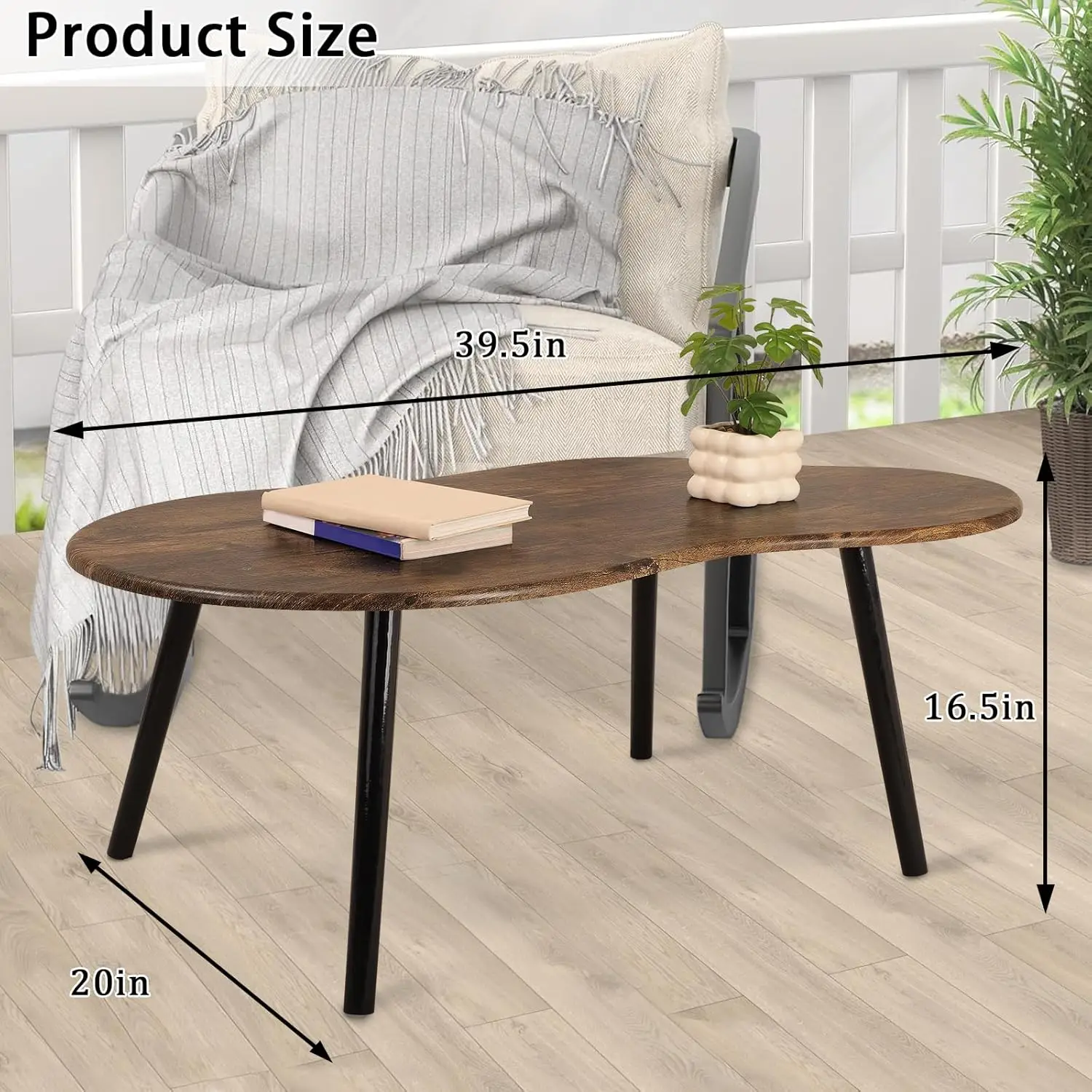
Key Characteristics:
- Organic yet geometric forms that blend curves with straight lines
- Tapered, angled legs that create a sense of lightness and energy
- Minimal ornamentation with emphasis on clean lines and material beauty
- Floating tops that appear to hover above bases
- Multi-level or modular designs that offer flexibility and visual interest
Our mid-century modern coffee table options showcase these distinctive features that define the style’s character. The most distinctive pieces often feature innovative approaches to materials and construction that were revolutionary for their time.
Materials That Define the Style:
Mid-century modern coffee tables typically feature warm-toned woods, with teak, walnut, and rosewood being particularly prized. The natural beauty of wood grain becomes a decorative element in itself, often complemented by glass tops or metal accents that create visual contrast.
The joinery in authentic mid-century pieces reveals their quality craftsmanship. Look for finger joints in drawers, elegantly tapered dowel legs, and the way components connect seamlessly without excessive hardware. These construction details contribute significantly to the character and value of vintage mid-century tables.
Recognizing Quality and Authenticity:
Genuine mid-century modern coffee tables possess proportions that feel perfectly balanced – not too heavy, not too delicate. The relationship between top and base creates visual harmony that reproductions often fail to capture. Authentic pieces also feature consistent attention to detail on all sides, reflecting an era when furniture was designed to float in space rather than press against walls.
Many styles complement mid-century modern design beautifully, from contemporary minimalist to eclectic bohemian approaches. This versatility explains why these vintage pieces continue to be prized by collectors and casual decorators alike – they bring character while harmonizing with diverse interior styles.
Art Deco and Hollywood Regency: Glamour and Geometric Flair
The bold geometric patterns and luxurious materials of Art Deco coffee tables (1920s-1930s) and the dramatic glamour of Hollywood Regency pieces (1930s-1970s) bring sophisticated character to any interior. These styles celebrate visual drama and decorative richness that contrasts with the restraint of mid-century modernism.
Art Deco Characteristics:
- Bold geometric patterns and symmetrical designs
- Exotic wood veneers in dramatic sunburst or waterfall patterns
- High-contrast materials like black lacquer with metal inlays
- Stepped or ziggurat forms inspired by ancient architecture
- Rich, glossy finishes that emphasize luxury
Hollywood Regency Characteristics:
- Dramatic proportions that create visual statements
- Mirrored surfaces that reflect light and create glamour
- Greek key motifs and neoclassical references
- Lacquered finishes in bold colors or high-gloss black
- Ornate metal bases in gold, brass, or chrome finishes
Both styles often incorporate marble elements common in glamorous designs, from dramatic veined tops to inset panels that add luxury and visual weight. These stone elements develop beautiful patina over time, with subtle signs of wear that enhance rather than diminish their character.
The hardware and decorative elements in these styles are particularly distinctive. Art Deco pieces often feature geometric pulls in chrome or brass, while Hollywood Regency tables might showcase more ornate hardware with bamboo or Greek key motifs. These details are often what collectors seek when identifying authentic pieces with true character.
What makes these styles particularly interesting is their evolution over time and their influence on each other. Late Art Deco pieces began incorporating curved elements that would later define Hollywood Regency, while both styles share a commitment to visual drama and luxurious materials that create instant focal points in a room.
Industrial and Brutalist: Raw Power and Sculptural Presence
Industrial and Brutalist coffee tables bring bold, sculptural character to interiors through raw materials, unconventional forms, and celebration of structural elements. These distinctive styles offer dramatic counterpoints to more refined furniture, adding visual tension and artistic presence to living spaces.
Industrial Characteristics:
- Factory-inspired components repurposed as furniture
- Visible mechanics like gears, casters, or adjustable elements
- Raw, unfinished metals with natural patina or intentional rust
- Reclaimed wood with visible history and wear
- Utilitarian forms that honestly express their function
- Exposed fasteners and structural elements
The character of industrial coffee tables comes from their authentic connection to working environments and machinery. Original industrial pieces often incorporate salvaged factory equipment, like gear wheels, machine bases, or work surfaces that have been repurposed. The honest materials and visible construction create coffee tables that feel substantial and unpretentious.
Brutalist Characteristics:
- Sculptural, abstract forms with dramatic visual impact
- Textured metal surfaces, often hand-worked bronze or brass
- Jagged, irregular silhouettes that create dynamic tension
- Monolithic presence with substantial visual weight
- Complex geometric patterns with depth and dimension
- Artistic expression prioritized over conventional function
Brutalist coffee tables function as sculptural art objects while serving practical purposes. Their distinctive character comes from their bold artistic expression and rejection of traditional furniture aesthetics. Many feature torch-cut or hand-worked metal components that create intricate shadows and visual complexity.
When integrating these bold design styles into your space, consider creating contrast through softer surrounding elements. Textiles like plush rugs or soft upholstery help balance the hard edges and raw materials of these dramatic tables.
The construction techniques in both styles often reveal their character. Industrial pieces showcase functional joinery and practical engineering, while Brutalist tables feature more artistic, sculptural connections between elements. These visible construction methods become part of the aesthetic expression rather than being concealed.
Both styles demonstrate how character in vintage coffee tables can come from boldness and artistic expression rather than refinement and traditional craftsmanship. Their distinctive presence makes them natural conversation pieces and focal points in contemporary interiors.
Rustic, Global, and Eclectic: Organic Character and Cultural Richness
Coffee tables with rustic charm, global influences, or eclectic combinations bring warmth, cultural depth, and organic character to living spaces. These styles celebrate natural materials, handcraft traditions, and the beauty of imperfection in ways that create deeply personal interior statements.
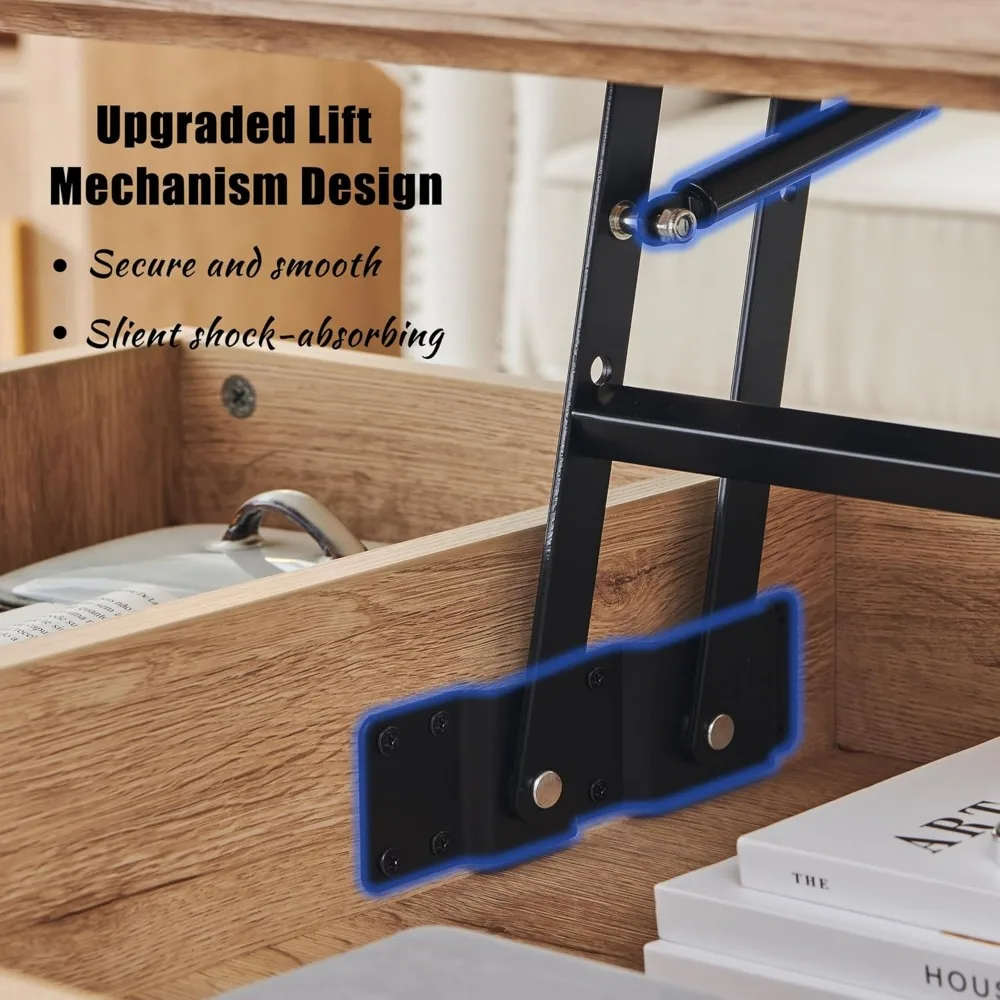
Rustic and Farmhouse Characteristics:
- Reclaimed barn wood or weathered timber with visible history
- Live-edge slabs that preserve the natural form of the tree
- Visible joinery like pegs, dovetails, or mortise and tenon
- Hand-planed surfaces with subtle texture and irregularity
- Sturdy, practical proportions that emphasize function and longevity
The character in rustic coffee tables emerges from their connection to natural materials and traditional craftsmanship. Each piece tells a story through knots, grain patterns, and honest wear that reflects years of use. The imperfections become distinguishing features that can’t be replicated in mass production.
Global and Ethnic-Inspired Characteristics:
- Hand-carved details reflecting specific cultural traditions
- Intricate inlay work using contrasting woods or materials
- Traditional construction techniques unique to particular regions
- Symbolic motifs and patterns with cultural significance
- Materials indigenous to specific geographic areas
Global vintage coffee tables bring rich cultural narratives into your space. Whether featuring Moroccan geometric patterns, Japanese joinery techniques, or African carved elements, these pieces connect your interior to broader world traditions and handcraft legacies.
Bohemian and Eclectic Combinations:
- Mixed materials creating unexpected textural contrasts
- Repurposed objects integrated into coffee table design
- Artistic expression through color, pattern, and unusual form
- Personalized elements that reflect individual stories
- Freedom from conventional design rules
Incorporating eclectic elements with mid-century style creates dynamic, personalized spaces that resist categorization. These combinations often yield the most character-rich interiors, where vintage pieces from different eras and traditions create dialogue through their juxtaposition.
What unites these diverse approaches is their emphasis on authenticity, handcraft, and natural materials. Unlike mass-produced furniture, these vintage pieces carry the mark of human hands and cultural traditions, bringing depth and soul to contemporary living spaces.
Expert Guidance: Evaluating Condition and Authenticity
Finding vintage coffee tables with genuine character requires knowing how to distinguish quality pieces from compromised ones. This assessment involves understanding structural integrity, recognizing desirable patina versus damage, and identifying authentic vintage characteristics.
Assessing Structural Integrity
When evaluating a vintage coffee table, start by checking these critical structural elements:
- Stability test: Gently push the table from different angles to detect wobbling or structural weakness
- Join inspection: Examine where legs meet the table frame for any separation or repair evidence
- Level assessment: Place the table on flat ground to check if it sits evenly without rocking
- Weight distribution: Press down on different areas of the tabletop to ensure even support
- Drawer function: If applicable, open and close drawers to check for smooth operation and proper alignment
Understanding Signs of Age vs. Damage
Learning to differentiate between character-enhancing patina and condition issues that compromise value is essential:
- Desirable patina: Color deepening, gentle surface wear, subtle checking in wood, honest wear on edges
- Problematic damage: Deep gouges, water rings that penetrate finish, structural cracks, active wood rot
- Surface evaluation: Run your hand over wood surfaces to feel for roughness, splinters, or unstable veneer
- Finish assessment: Look for crazing (fine cracks in finish) which often indicates age but not necessarily damage
Knowledge about authentic material identification helps determine whether a piece features genuine materials like solid hardwood versus cheaper substitutes or newer replacements.
Identifying Original Features vs. Alterations
Detecting modifications that may affect authenticity and value requires close inspection:
- Hardware examination: Look for patina consistency between hardware and wood to identify replacements
- Screw inspection: Original screws often have irregular slots and uneven threading compared to modern versions
- Construction consistency: Check that joinery methods are consistent throughout the piece
- Finish uniformity: Examine finish under different light angles to spot areas of refinishing or repair
- Bottom/underside review: The underside often reveals the most honest information about age and construction
Authentication Tips
Identifying genuine vintage pieces involves looking for several key indicators:
- Maker’s marks: Check undersides, drawer interiors, and back panels for manufacturer labels or stamps
- Construction methods: Identify period-specific techniques like hand-cut dovetails or specific joint styles
- Material verification: Confirm wood species and quality through grain pattern and weight
- Design consistency: Ensure proportions and details align with known examples from the alleged period
- Hardware authenticity: Verify that pulls, knobs, and other hardware match the style and era of the piece
Common Reproduction Warning Signs
Be alert for these indicators that a piece might be a modern reproduction:
- Too perfect: Excessive uniformity or machine-precision in supposedly handcrafted elements
- Artificial distressing: Manufactured wear patterns that look intentional rather than naturally developed
- Material inconsistency: Modern woods or treatments that weren’t available during the claimed period
- Construction shortcuts: Modern assembly methods like staples or phillips-head screws in supposedly older pieces
- Finish irregularities: Artificially aged finishes that appear inconsistent or unnaturally applied
By developing these evaluation skills, you’ll be better equipped to find vintage coffee tables with authentic character and avoid costly mistakes or disappointing reproductions.
Finding the Perfect Fit: Practical Considerations for Your Space
Finding a vintage coffee table with character is exciting, but ensuring it works practically in your space is equally important. Consider these functional aspects to choose a piece that serves your needs while adding vintage charm.
Proper Dimensions
The right-sized coffee table creates balance in your seating arrangement:
- Length: Ideally 2/3 to 3/4 the length of your sofa for visual proportion
- Width: Allow for comfortable movement around the table (usually 18-24 inches (46-61 cm) from seating)
- Distance between seating: Ensure 12-18 inches (30-46 cm) of clearance between table edges and seating for comfort
- Room proportion: Consider how the table’s footprint relates to the overall room size and layout
Height Considerations
The table height significantly impacts comfort and functionality:
- Standard height: Most coffee tables measure 16-18 inches (40-46 cm) tall
- Relationship to seating: Ideally, the table surface should be level with or 1-2 inches (2.5-5 cm) lower than sofa seat height
- Usage patterns: Consider how you’ll primarily use the table (casual dining might require higher surfaces)
- Surrounding furniture: Ensure consistent heights with nearby side tables for visual coherence
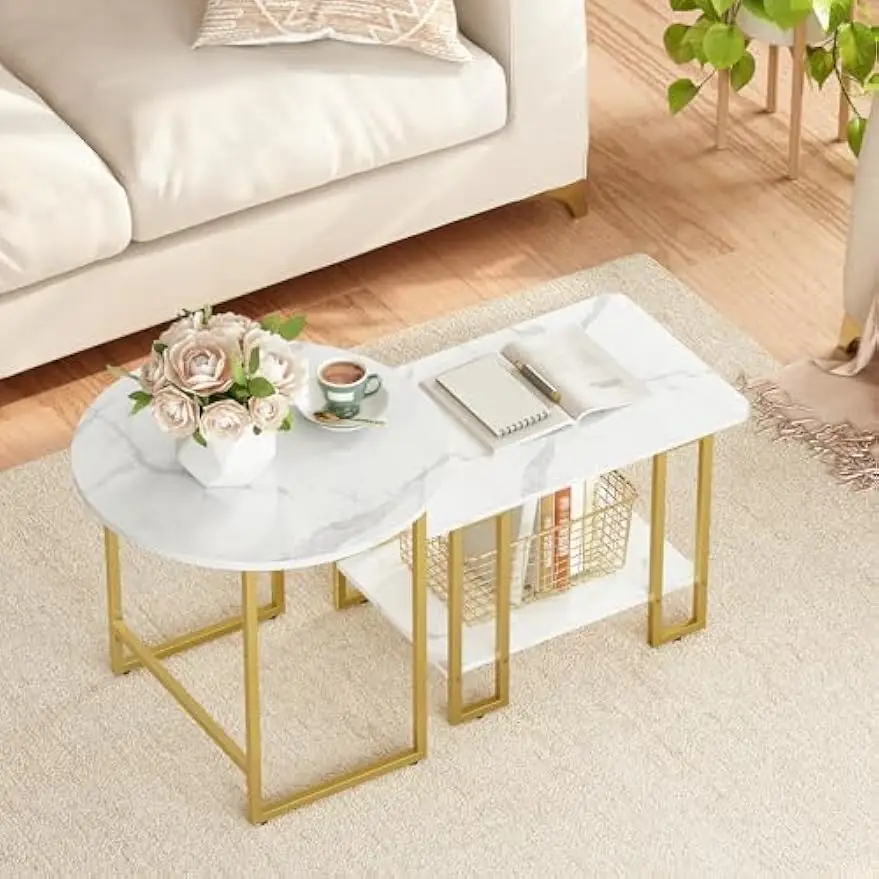
Visual Weight and Proportion
The table’s perceived mass should balance with surrounding furniture:
- Heavy sofas: Pair with substantial tables that can visually anchor the arrangement
- Light seating: Choose tables with more delicate profiles or transparent elements
- Room scale: Larger rooms can accommodate more substantial pieces, while smaller spaces benefit from lighter visual weight
- Balance assessment: Step back and evaluate whether the table feels proportionally correct within your arrangement
For those with limited space, using vintage tables in small spaces often requires creative solutions like space-saving nesting table options that offer flexibility without sacrificing character.
Functionality Assessment
Consider how your lifestyle impacts table requirements:
- Surface area: Ensure adequate space for your typical items (books, drinks, decorative objects)
- Storage needs: Some vintage tables include drawers, shelves, or compartments for concealed storage
- Material durability: Consider whether the table surface can withstand your usage patterns
- Edge safety: Rounded edges may be preferable for households with children
- Maintenance requirements: Some materials require more regular care than others
Traffic Flow
Your table should complement, not obstruct, movement through your space:
- Clearance paths: Allow 18-24 inches (46-61 cm) minimum between the table and other furniture for walkways
- Room circulation: Consider how people typically move through the space and position accordingly
- Accessibility: Ensure the table doesn’t block natural paths to doors, windows, or other furniture
- Flexibility needs: Consider whether the table might need to be moved occasionally for activities
By balancing these practical considerations with your aesthetic preferences, you’ll find a vintage coffee table with character that enhances your daily life while making a design statement that reflects your personal style.
Styling Your Character Piece: Creating Harmony and Showcasing Uniqueness
Once you’ve found the perfect vintage coffee table, thoughtful styling helps integrate it into your space while highlighting its distinctive character. The right approach creates balance between showcasing your table’s unique features and ensuring it harmonizes with your overall interior.
Complementary Elements
Creating successful relationships between your vintage table and surrounding furniture:
- Pair angular vintage tables with softer, upholstered seating for textural contrast
- Echo materials or colors from your vintage piece in smaller accessories
- Balance ornate vintage tables with simpler surrounding pieces to prevent visual competition
- Consider scale relationships—substantial tables need equally substantial surrounding furniture
Creating Balance
Strategies for successful mixing of vintage and contemporary elements:
- Use color as a unifying element across different furniture styles and eras
- Incorporate transitional pieces that bridge between vintage and modern aesthetics
- Repeat shapes or lines from your vintage table in more contemporary elements
- Create rhythm through consistent heights or proportions across different furniture styles
Tabletop Styling
Showcase your vintage table’s character while maintaining functionality:
- Follow the rule of three—group objects in odd numbers for visual interest
- Create height variation with stacked books, sculptural objects, and lower elements
- Allow negative space to highlight special features of the table surface
- Choose objects that complement but don’t compete with your table’s character
- Incorporate elements that reference the table’s era without creating a time-capsule effect
Our collection of styling ideas for character pieces provides additional inspiration for highlighting your vintage table’s unique qualities while maintaining a cohesive look.
Surrounding Elements
Enhance your vintage coffee table with complementary accessories:
- Choose rugs that provide contrast—textured rugs with sleek tables or simple rugs with ornate pieces
- Position lighting to highlight special features like wood grain or decorative elements
- Select art that complements rather than competes with your statement table
- Consider how floor material interacts with your table’s style and presence
Color Palettes
Working with or against your vintage piece’s dominant tones:
- Build a palette that includes your table’s wood tone or primary material as a neutral
- Use complementary colors to make wood tones appear richer and more vibrant
- Create depth by incorporating various shades of your table’s dominant color
- Consider contrast strategies—dark tables pop against lighter surroundings while light tables anchor darker spaces
By thoughtfully styling your vintage coffee table, you create an environment that celebrates its character while ensuring it functions beautifully within your daily life and overall design scheme.
Where to Hunt: Finding Vintage Coffee Tables With True Character
The search for the perfect vintage coffee table with character requires knowing where to look and how to evaluate potential treasures. Each source has its own advantages and challenges, but all offer the possibility of discovering that special piece with history and personality.
Curated Online Marketplaces
Online platforms have revolutionized vintage furniture shopping by connecting buyers with sellers across wide geographic areas:
- Specialized vintage platforms offer curated selections with detailed descriptions and provenance information
- General marketplaces provide broader selection but require more knowledge to identify quality pieces
- Dealer collective sites feature items from multiple professional dealers with expertise in specific eras
- Auction platforms can yield exceptional finds but require quick decision-making and sometimes competitive bidding
When shopping online, scrutinize photos carefully, request additional images of specific areas, and don’t hesitate to ask detailed questions about condition, dimensions, and history.
Local Vintage and Antique Stores
Physical retail locations offer the advantage of in-person inspection:
- Dedicated vintage furniture stores often have knowledgeable staff who can provide background information
- Antique malls feature multiple dealers with varying specialties and price points
- Consignment shops frequently have one-of-a-kind pieces at reasonable prices
- Vintage collectives bring together multiple vendors with curated selections
Building relationships with local dealers can be particularly valuable, as they may contact you when pieces matching your interests arrive.
Estate Sales and Auctions
These events offer opportunities to find pieces directly from original owners:
- Estate sales provide access to furniture in its original setting, often with complete sets available
- Live auctions feature professionally vetted items but can move quickly
- Estate auction platforms combine the convenience of online with the provenance of estate sources
- Moving sales can yield well-priced finds from homeowners looking to downsize quickly
Arriving early to these events is often essential for accessing the best selection of coffee tables with distinctive character.
Our sought-after vintage materials like walnut are particularly worth watching for at these events, as they often indicate quality construction and design significance.
Flea Markets and Thrift Stores
These hunting grounds require more effort but can yield remarkable discoveries:
- Regular visits increase your chances of finding hidden gems
- Early morning shopping gives you first access to newly displayed items
- Thoroughness pays off—check all areas as categorization may be inconsistent
- Vision helps identify potential beneath dirt or minor condition issues
Develop a quick assessment routine to efficiently evaluate pieces for quality and condition amid less curated environments.
Working with Dealers
Specialized vintage dealers can become valuable partners in your search:
- Communicate your specific interests clearly to help them watch for suitable pieces
- Build long-term relationships that may give you first access to new acquisitions
- Learn from their expertise about identifying distinctive vintage features
- Consider approval arrangements that allow you to see pieces in your space before committing
Search Strategies
Efficient searching helps you find exceptional pieces before others:
- Use specific terminology related to era, style, and materials rather than just “vintage coffee table”
- Set up alerts on marketplace platforms for specific designs or materials
- Search for misspellings or incorrect descriptions that might cause others to overlook good pieces
- Look beyond furniture categories as some sellers may list tables under “decor” or other classifications
- Check listings regularly as the best pieces often sell quickly
The hunt for vintage coffee tables with true character is part of the joy of collecting—each search represents an opportunity to discover a piece with history, craftsmanship, and distinctive presence that will enhance your space for years to come.
Mid-Century Modern Solid Wood Coffee Tables, Mid-Century Modern Teak Coffee Tables
$879.95 Select options This product has multiple variants. The options may be chosen on the product pageMid-Century Modern Danish Coffee Tables, Mid-Century Modern Oval Coffee Tables, Mid-Century Modern Solid Wood Coffee Tables
$390.05 Select options This product has multiple variants. The options may be chosen on the product pageMid-Century Modern Coffee & End Table Sets, Mid-Century Modern Coffee Table Sets, Mid-Century Modern Oval Coffee Tables
Price range: $257.48 through $331.04 Select options This product has multiple variants. The options may be chosen on the product pageMid-Century Modern Glass Top Coffee Tables, Mid-Century Modern Glass Top Side & End Tables
$460.58 Select options This product has multiple variants. The options may be chosen on the product pageMid-Century Modern Glass Top Coffee Tables, Mid-Century Modern Vintage Coffee Tables, Mid-Century Modern Vintage Side & End Tables
$725.36 Select options This product has multiple variants. The options may be chosen on the product pageMid-Century Modern Lift Top Coffee Tables, Mid-Century Modern Square Coffee Tables
$454.73 Select options This product has multiple variants. The options may be chosen on the product page
Making the Purchase: Valuation, Negotiation, and Logistics
Once you’ve found a vintage coffee table with character that speaks to you, navigating the purchase process requires understanding value, negotiation approaches, and practical transportation considerations.
Understanding Fair Market Value
Several factors influence the appropriate price for vintage coffee tables:
- Designer attribution: Pieces by recognized designers typically command premium prices
- Rarity: Uncommon models or limited production runs have greater value
- Condition: Original finishes and minimal damage significantly impact worth
- Material quality: Solid hardwoods and premium materials justify higher prices
- Provenance: Documented history or original paperwork adds value
- Market demand: Current popularity of specific styles affects pricing
Research comparable sales online and in auction records to establish reasonable price expectations before making offers.
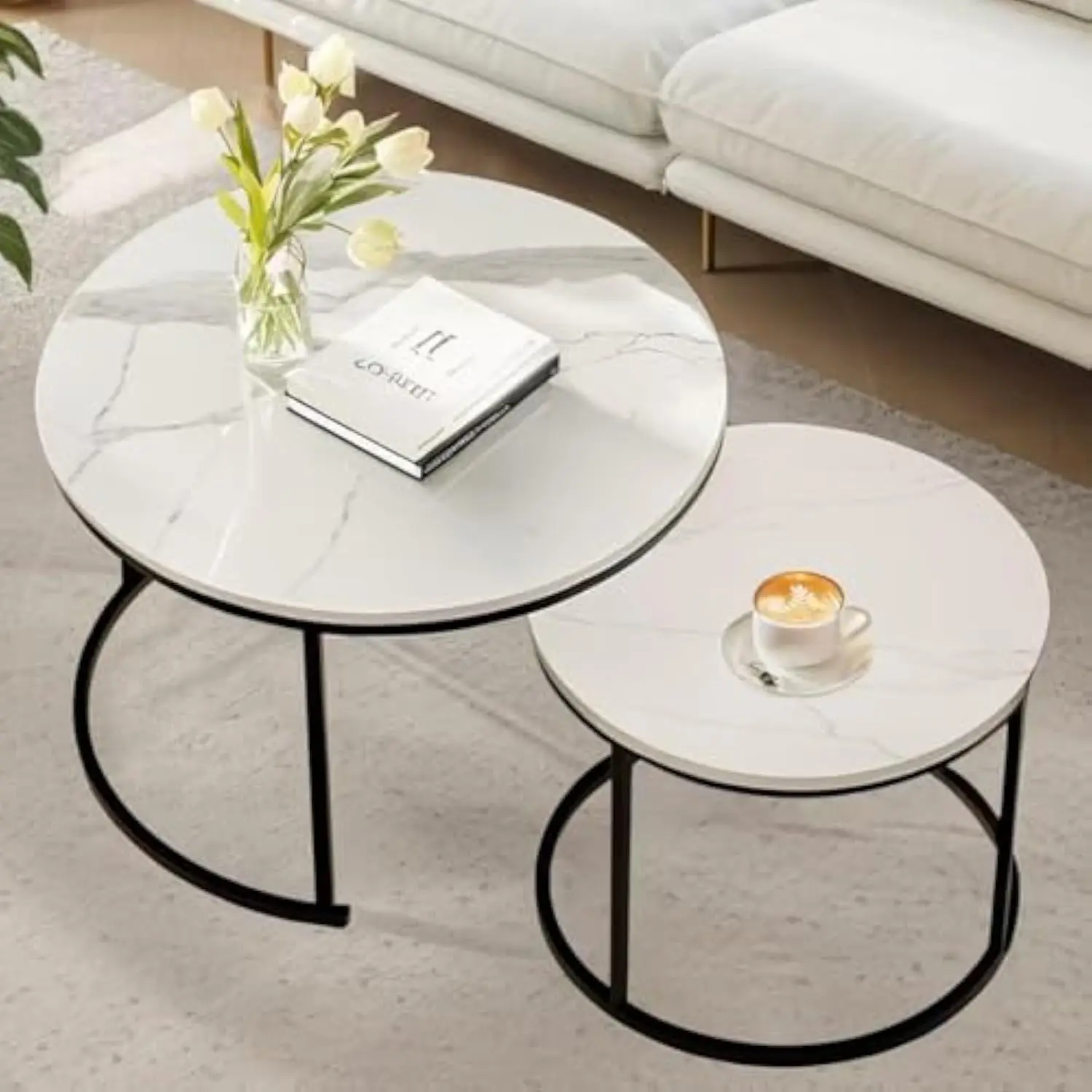
Negotiation Strategies
Different selling venues call for different negotiation approaches:
- Retail vintage stores: Modest discounts (10-15%) are often possible, especially for cash purchases
- Antique shows: Dealers typically build some negotiation margin into prices, particularly on the final day
- Private sellers: More significant negotiation potential, especially if items have been listed for some time
- Auctions: Set your maximum bid before beginning and stick to it to avoid emotional overspending
Always approach negotiations respectfully, focusing on fair value rather than aggressive bargaining. Point out condition issues factually rather than dramatically, and be prepared to explain your offer rationale.
Transportation Considerations
Getting your vintage coffee table home safely requires careful planning:
- Measurements: Confirm all dimensions fit through doorways, stairwells, and elevators
- Professional movers: Worth considering for valuable or particularly heavy pieces
- Proper wrapping: Blankets, bubble wrap, and corner protectors prevent transit damage
- Vehicle selection: Some tables disassemble for easier transport; others require larger vehicles
- Delivery timing: Coordinate carefully to ensure someone is present to receive and inspect the piece
For online purchases, carefully review shipping methods and insurance coverage, particularly for glass or marble elements that require special handling.
Budget Planning
Consider the total cost of ownership beyond the purchase price:
- Restoration needs: Factor in professional refinishing, repair, or upholstery costs if needed
- Delivery expenses: Long-distance shipping can add significantly to total cost
- Special care requirements: Some materials need specific products or maintenance routines
- Insurance considerations: Valuable vintage pieces may warrant additional coverage
For pieces requiring restoration, get estimates before purchasing to ensure the total investment aligns with the table’s value and your budget.
Documentation
Preserving information about your vintage coffee table enhances both enjoyment and potential future value:
- Provenance records: Keep any available history, receipts, or original documentation
- Condition reports: Document the table’s condition at purchase with detailed photos
- Designer information: Research and record details about the designer or manufacturer
- Receipt preservation: Keep purchase information including date and source
This documentation helps tell your table’s story and can be valuable if you ever decide to sell or insure the piece.
Caring for Your Vintage Treasure: Maintenance and Restoration
Proper care ensures your vintage coffee table retains its character and value for generations to come. Different materials require specific approaches to cleaning and maintenance, while understanding when to attempt DIY versus seeking professional help protects your investment.
General Maintenance
Regardless of material, these practices help preserve all vintage coffee tables:
- Regular dusting with soft, lint-free cloths prevents buildup that can scratch surfaces
- Immediate attention to spills prevents liquid damage to wood and other porous materials
- Consistent humidity levels (40-60%) prevent wood cracking, joint loosening, and veneer issues
- Felt pads under items protect surfaces from scratches and rings
- Periodic inspection of joints, hardware, and structural elements catches issues early
- Avoiding direct sunlight prevents fading, drying, and potential cracking
Material-Specific Care
Different materials common in vintage tables requiring specific care need tailored approaches:
Wood:
* Clean with minimal moisture using a slightly damp cloth followed by immediate drying
* Apply appropriate wood care products based on finish type (oil, shellac, lacquer, etc.)
* Use high-quality furniture wax 2-3 times yearly to nourish wood and maintain luster
* Address water rings quickly with appropriate techniques for the specific finish
Metal:
* Clean brass and copper with appropriate metal cleaners that won’t remove desirable patina
* Wipe chrome with soft cloths and mild soap solutions, avoiding abrasives
* Apply thin coats of paste wax to protect iron elements from moisture
* Address any rust spots immediately before they spread
Glass:
* Clean with ammonia-free glass cleaners to avoid damaging surrounding wood or metal
* Support glass properly when cleaning to prevent pressure cracks
* Use microfiber cloths rather than paper towels to avoid scratching
* Check for edge chips regularly as these can expand with use
Stone:
* Seal marble and other porous stone surfaces annually to prevent staining
* Clean with pH-neutral stone cleaners to avoid etching or damage
* Use coasters religiously to prevent acidic liquid damage
* Address chips or cracks immediately to prevent expansion
When to DIY vs. Professional Restoration
Understanding the limits of DIY maintenance protects valuable vintage pieces:
Appropriate DIY tasks:
* Light cleaning and dusting
* Waxing and polishing stable finishes
* Tightening loose hardware
* Minor touch-ups to small scratches
* Applying leather conditioners to leather elements
Situations requiring professionals:
* Structural repairs to joints or supports
* Refinishing wood surfaces
* Repairing veneer damage or loss
* Addressing significant water or heat damage
* Restoring valuable or rare pieces where mistakes would be costly
Finding Restoration Specialists
When professional help is needed:
- Seek specialists with specific experience in your table’s era and style
- Request examples of similar restoration projects
- Ask about their approach to maintaining patina and character
- Discuss restoration philosophy – preservation versus full refinishing
- Get detailed written estimates outlining all work to be performed
Preserving Value
Certain practices help maintain both the character and investment value of vintage coffee tables:
- Maintain original finishes whenever possible as they contribute significantly to authenticity
- Keep all original hardware, storing removed pieces safely if replacements are needed
- Document all restoration work performed
- Use reversible techniques when modifications are necessary
- Store removed original elements with the piece when possible
With proper care and thoughtful maintenance, your vintage coffee table will continue developing character while remaining a functional, beautiful part of your home for decades to come.
Should You Refinish? Balancing Preservation and Personal Preference
One of the most common dilemmas facing owners of vintage coffee tables is whether to refinish or preserve original surfaces. This decision involves balancing authenticity, value considerations, and your personal aesthetic preferences.
When Refinishing Affects Value
Understanding the potential impact on a piece’s worth:
Original finishes typically preserve value when:
* The piece has significant historical importance
* The maker or designer is particularly notable
* The patina shows attractive, genuine age rather than damage
* The original finish represents period-specific techniques
* The table is rare or from a limited production run
Value is less affected by refinishing when:
* The piece is more common or from mass production
* The original finish is significantly damaged beyond patina
* The table has already been refinished previously
* The piece lacks attribution to notable makers
* You plan to keep the table long-term rather than resell
Respectful Updates
Approaches that honor a piece’s history while meeting your needs:
- Selective restoration that addresses damage while preserving character-rich areas
- Cleaning and reviving existing finishes rather than removing them
- Stabilizing rather than replacing original elements
- Reversible modifications that allow future restoration to original condition
- Documented changes that maintain the piece’s history and provenance
Evaluating Potential
Seeing the possibilities in pieces that might benefit from refinishing:
Questions to consider:
* Is the damage superficial or structural?
* Does the current condition obscure the table’s design excellence?
* Would cleaning and polishing be sufficient, or is refinishing truly needed?
* Are there specific areas that need attention while others could remain untouched?
* What would the original designer have intended for the piece’s appearance?
Partial Restoration
Compromise approaches that balance preservation with improvement:
- Touch up small areas rather than refinishing entire surfaces
- Address structural issues while maintaining original finishes
- Clean deeply before deciding if further refinishing is necessary
- Consider using conservation techniques that stabilize rather than replace
Decision Framework
Questions to guide your refinishing decision:
- Is the piece rare or historically significant?
- Does the current finish actively detract from the design’s beauty?
- Will refinishing remove important evidence of age and authenticity?
- Do you value the piece primarily for its history or its aesthetic in your space?
- Would a professional conservator recommend preservation or restoration?
The most thoughtful approach often lies between complete preservation and full refinishing. By addressing specific issues while maintaining character-building patina, you can enjoy both the beauty and the history of your vintage coffee table. When in doubt, consult with restoration professionals who specialize in vintage furniture before making irreversible changes.
Can You Mix Vintage Coffee Tables With Modern Decor?
Not only can you mix vintage coffee tables with contemporary elements, but this combination often creates the most dynamic, layered interiors with depth and personality. The contrast between old and new highlights the distinctive character of both, creating visual interest that purely matched sets cannot achieve.
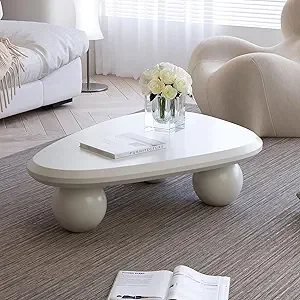
Why Mixed Eras Work So Well
The appeal of combining vintage tables with modern surroundings:
- Creates visual tension that draws attention and interest
- Prevents rooms from feeling like time capsules or showrooms
- Adds warmth and soul to contemporary spaces that might otherwise feel cold
- Demonstrates personal style and thoughtful curation rather than package purchasing
- Allows individual pieces to shine as focal points rather than blending into matched sets
Strategies for Successful Integration
Techniques that help vintage and modern elements harmonize:
- Use color as a unifying element—pick up wood tones from your vintage table in modern textiles or art
- Create balance through proportion—pair substantial vintage pieces with equally substantial modern elements
- Establish rhythm by repeating shapes or lines from your vintage table in contemporary accessories
- Use textural contrast to highlight the unique materials and finishes of different eras
- Create conversation between pieces through complementary forms or functions
Modern styling with vintage pieces works particularly well when there’s thoughtful consideration of how elements relate to each other beyond their era or style classification.
Style Combinations That Work Particularly Well
Certain pairings naturally complement each other:
- Mid-century modern coffee tables with minimalist contemporary seating creates clean-lined harmony
- Industrial vintage tables add warmth and character to sleek modern lofts
- Art Deco pieces bring glamour and sophistication to contemporary neutral schemes
- Rustic vintage tables add grounding texture to modern spaces with lots of glass and metal
- Asian-influenced vintage pieces create elegant focal points in contemporary settings
Creating Cohesion Across Eras
Techniques for binding different time periods together:
- Use art that references both vintage and contemporary elements
- Choose a consistent color palette that incorporates both old and new pieces
- Add transitional elements that bridge between different style periods
- Maintain consistent scale and proportion throughout the space
- Repeat key materials across different eras of furniture
The most successful interiors often feature this thoughtful mixing of periods and styles, with vintage coffee tables serving as character-rich anchors amid more contemporary surroundings. This approach creates homes that feel collected over time rather than purchased all at once—spaces with depth, personality, and stories to tell.
Is a Vintage Coffee Table Right for Your Lifestyle?
While vintage coffee tables offer unique character and quality, they’re not automatically the right choice for every household. Consider these practical factors to determine whether a vintage piece aligns with your specific lifestyle needs.
Households with Children and Pets
Practical considerations for active homes:
- Many vintage tables feature sturdy construction that withstands active use better than some modern counterparts
- Solid wood vintage pieces often hide minor scratches and wear better than new veneered furniture
- Some vintage styles feature rounded edges and corners that may be safer for young children
- Existing patina can be an advantage—minor new marks blend into the established character
- Consider tables without glass elements if you have very active children or pets
Protective measures like custom glass tops can preserve delicate surfaces while maintaining visibility of beautiful wood grain or design details.
Material Durability Considerations
How different vintage materials stand up to daily use:
- Solid hardwood tables from the mid-century typically offer excellent durability for everyday use
- Original finishes on vintage pieces may be more delicate than modern polyurethane coatings
- Marble and stone tops are generally durable but can stain or etch from acidic substances
- Glass elements require consistent use of coasters and careful handling
- Veneers vary significantly in thickness and durability between different eras and makers
Adaptability to Different Living Situations
How vintage pieces transition between homes and life stages:
- Many vintage coffee tables feature versatile sizes that work in various spaces
- Quality construction means these pieces can move repeatedly without deteriorating
- Timeless designs remain relevant through changing trends and home styles
- Some vintage pieces offer adaptable features like expandable surfaces or nested components
- Investment-quality vintage often maintains resale value if your needs change
Practical Solutions for Common Concerns
Ways to address potential issues with vintage pieces:
- Custom-cut glass tops protect delicate wood surfaces without hiding their beauty
- Quality coasters and placemats prevent damage from drinks and dining
- Felt pads under decorative objects prevent scratches on surfaces
- Professional cleaning and conditioning help maintain original finishes
- Strategic placement away from direct sunlight prevents fading and wood drying
For many households, the unique character and quality construction of vintage coffee tables outweigh any additional care requirements. These pieces often become more beloved over time as they develop additional patina that reflects your family’s own history alongside their original character.
Embracing the Hunt: The Joy of Finding Your Perfect Character Piece
The search for a vintage coffee table with true character is about much more than simply furnishing your home. It’s an adventure that rewards patience, knowledge, and the thrill of discovery with a piece that brings history, craftsmanship, and distinctive personality to your living space.
Unlike the immediate gratification of purchasing new furniture, finding the perfect vintage piece often requires time and persistence. This extended search creates a deeper connection to the table you eventually choose. When you finally discover that ideal combination of style, condition, and character that speaks to you personally, the emotional reward far exceeds what any quick purchase can provide.
What makes vintage coffee tables so special is how they become part of your own story while carrying their previous history. The coffee table that witnessed family gatherings decades ago now becomes the center of your own home life, adding layers of meaning that new furniture simply cannot offer. These character-rich pieces develop relationships with their owners, becoming more valuable emotionally as they continue developing subtle patina that reflects your life together.
The knowledge gained through searching for vintage furniture—understanding materials, recognizing craftsmanship, appreciating design history—enriches your relationship with all the objects in your home. You begin seeing furniture differently, noticing details and qualities that previously went unrecognized. This growing appreciation transforms how you experience spaces, both your own and others.
At Hearth Forms, we understand the profound satisfaction that comes from discovering pieces with authentic character and timeless appeal. The vintage coffee tables that capture our attention and earn our admiration are those that demonstrate exceptional design integrity, quality materials, and the distinctive personality that only time and craftsmanship can create.
As you embark on your own search for the perfect vintage coffee table, embrace the journey rather than rushing to a destination. Visit local shops repeatedly, develop relationships with dealers who share your passion, and educate yourself about the styles and periods that speak to you. The perfect piece with genuine character is out there waiting to be discovered—and when you find it, it will transform your space in ways that transcend mere decoration, creating a home that truly reflects your appreciation for quality, history, and timeless design.

